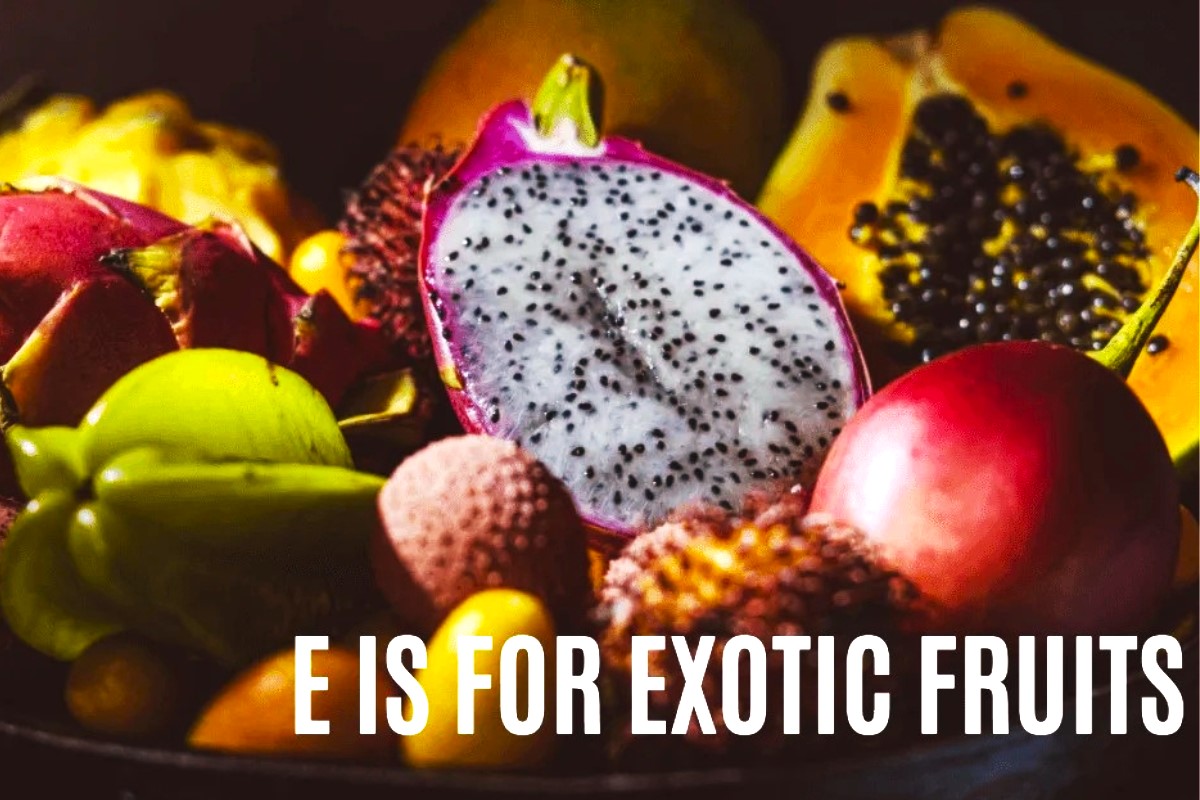Home>Food and Cooking>10 Exotic Fruits That Start With The Letter ‘E’


Food and Cooking
10 Exotic Fruits That Start With The Letter ‘E’
Published: January 26, 2024
Discover 10 exotic fruits that start with the letter 'E' and add a unique twist to your food and cooking adventures. Explore new flavors and recipes with these rare and delicious fruits.
(Many of the links in this article redirect to a specific reviewed product. Your purchase of these products through affiliate links helps to generate commission for Noodls.com, at no extra cost. Learn more)
Table of Contents
Elderberries
Elderberries, the dark purple fruit of the elder tree, are not only visually striking but also packed with nutritional benefits. These tiny fruits are rich in antioxidants, vitamins, and minerals, making them a valuable addition to various culinary creations and traditional remedies.
Nutritional Powerhouse
Elderberries are renowned for their exceptional nutritional profile. They are a great source of dietary fiber, vitamin C, and antioxidants, including flavonoids and anthocyanins. These antioxidants play a vital role in neutralizing harmful free radicals in the body, thereby supporting overall health and well-being.
Culinary Uses
Despite their tart flavor when raw, elderberries are a versatile ingredient in the culinary world. They are often used to create delicious jams, jellies, and syrups. Additionally, elderberries can be transformed into flavorful sauces that pair well with savory dishes, particularly game meats. The deep, rich color of elderberries also makes them a popular choice for adding a vibrant hue to desserts and beverages.
Medicinal Benefits
For centuries, elderberries have been utilized for their potential medicinal properties. They are believed to possess immune-boosting and anti-inflammatory properties, making them a common ingredient in natural remedies for colds and flu. Elderberry syrup, in particular, is a popular natural supplement known for its potential to alleviate cold and flu symptoms.
Precautions
While elderberries offer numerous health benefits, it's important to note that consuming raw elderberries is not recommended, as they contain cyanide-inducing glycosides. Proper cooking or drying of the berries is essential to eliminate any potential toxicity. Additionally, individuals with certain health conditions or those taking specific medications should consult a healthcare professional before incorporating elderberry products into their diet.
In summary, elderberries are not only a visually appealing fruit but also a nutritional powerhouse with diverse culinary and potential medicinal uses. From vibrant jams to immune-boosting syrups, these small yet mighty berries continue to captivate the interest of food enthusiasts and health-conscious individuals alike.
Emblica
Emblica, also known as Indian gooseberry or amla, is a small, green fruit that holds significant cultural and medicinal importance in various parts of the world, particularly in India. Renowned for its tartness and vibrant green color, this fruit is celebrated for its diverse culinary applications and extensive health benefits.
Culinary Significance
In Indian cuisine, emblica is revered for its unique flavor profile and is commonly used in pickles, chutneys, and savory dishes. Its high vitamin C content and tangy taste make it a popular ingredient in traditional Indian recipes, adding a refreshing and sour note to a wide array of culinary creations. Additionally, emblica is often incorporated into sweet preserves, candies, and beverages, showcasing its versatility in both savory and sweet dishes.
Medicinal Properties
Emblica has been a staple in Ayurvedic medicine for centuries, valued for its potent medicinal properties. It is believed to possess antioxidant, anti-inflammatory, and immune-boosting properties, making it a key component in various herbal remedies and tonics. The fruit is also recognized for its potential to support digestive health and enhance skin and hair vitality. Whether consumed fresh, dried, or in powdered form, emblica continues to be an integral part of traditional healing practices and holistic wellness approaches.
Modern Applications
In recent years, emblica has garnered attention beyond its cultural origins, gaining popularity in the global health and wellness industry. Its rich nutrient profile, including high levels of vitamin C, has positioned it as a sought-after superfood and a prominent ingredient in dietary supplements, beauty products, and functional foods. The fruit's adaptability and nutritional density have contributed to its integration into modern dietary regimens and beauty routines, reflecting a harmonious blend of tradition and contemporary wellness trends.
Culinary Innovation
As emblica gains recognition on a global scale, chefs and food enthusiasts are exploring innovative ways to incorporate this distinctive fruit into a wide range of culinary creations. From emblica-infused cocktails and dressings to fusion desserts and gourmet preserves, the fruit's tangy and citrusy essence continues to inspire culinary experimentation and creative flavor pairings. Its ability to add a refreshing twist to traditional and modern dishes alike has sparked a wave of culinary innovation, inviting individuals to explore the unique sensory experience that emblica offers.
Embracing Emblica
In essence, emblica stands as a symbol of cultural heritage, holistic wellness, and culinary inspiration. Its remarkable journey from traditional Ayurvedic practices to contemporary global wellness trends exemplifies the enduring allure of this small yet impactful fruit. Whether enjoyed for its vibrant flavor, cherished for its health-enhancing properties, or celebrated for its culinary versatility, emblica continues to captivate the senses and leave a lasting impression on those who embrace its extraordinary potential.
Elephant Apple
The Elephant Apple, scientifically known as Dillenia indica, is a unique fruit that is native to the Indian subcontinent and parts of Southeast Asia. Despite its name, the Elephant Apple is not a true apple but rather a large, woody fruit that grows on the Dillenia indica tree, which is revered for its cultural significance and diverse culinary applications.
Cultural Significance
In regions where the Elephant Apple thrives, it holds a special place in local traditions and folklore. The fruit is deeply intertwined with cultural practices and is often associated with auspicious occasions and religious ceremonies. Its distinct appearance and tangy flavor make it a notable ingredient in traditional dishes, and its presence in local folklore reflects the fruit's enduring significance within the fabric of indigenous cultures.
Unique Characteristics
The Elephant Apple is characterized by its large, round shape and rough, woody exterior. When ripe, the fruit exudes a subtle fragrance and yields a tart, acidic flavor with hints of sweetness. Its flesh, which ranges from pale yellow to light orange, contains numerous small seeds embedded within a juicy pulp. Despite its initial sourness, the Elephant Apple's flavor profile lends itself well to a variety of culinary preparations, making it a versatile and intriguing ingredient in regional cuisines.
Culinary Applications
In culinary traditions, the Elephant Apple is utilized in a multitude of ways, showcasing its adaptability and distinctive taste. The fruit is often used to prepare chutneys, pickles, and tangy sauces that complement savory dishes, adding a refreshing and piquant element to the overall flavor profile. Additionally, its juice is extracted and used to create refreshing beverages, and its pulp is incorporated into jams and preserves, offering a delightful balance of tartness and natural sweetness.
Nutritional Value
Beyond its culinary appeal, the Elephant Apple also offers nutritional benefits. It is a good source of vitamin C, antioxidants, and dietary fiber, contributing to its potential health-enhancing properties. The fruit's tangy flavor and nutrient density make it a valuable addition to balanced diets and traditional wellness practices, reflecting its holistic significance within local communities.
Embracing the Elephant Apple
The Elephant Apple's rich cultural heritage and culinary versatility position it as a symbol of regional identity and gastronomic innovation. Its ability to infuse dishes with a unique blend of flavors and its potential health benefits underscore its enduring appeal. Whether enjoyed in traditional recipes or reimagined in contemporary culinary creations, the Elephant Apple continues to captivate the senses and serve as a testament to the rich tapestry of flavors and traditions found in its native regions.
Emu Apple
The Emu Apple, also known as the Muntries or Native Cranberries, is a unique fruit native to southern Australia, particularly the coastal regions of Victoria and South Australia. This small, round fruit, which grows on low-lying shrubs, holds significant cultural and culinary importance within indigenous Australian communities and has garnered attention for its distinctive flavor profile and potential health benefits.
Indigenous Cultural Significance
In indigenous Australian cultures, the Emu Apple has been a traditional food source for centuries, revered for its nutritional value and symbolic significance. It holds a prominent place in Aboriginal folklore and is often celebrated as a symbol of sustenance and connection to the land. The fruit's gathering and consumption are deeply rooted in cultural practices, reflecting a profound respect for the natural environment and the ancestral knowledge passed down through generations.
Unique Flavor Profile
The Emu Apple boasts a complex flavor profile characterized by a delightful blend of sweetness and tartness, reminiscent of a combination of apples and cranberries. Its distinct taste, coupled with a subtle crunch when bitten into, makes it a sought-after ingredient in both traditional and contemporary culinary creations. The fruit's flavor versatility allows it to be used in a wide range of dishes, from sweet jams and desserts to savory sauces and accompaniments, offering a unique sensory experience that captivates the palate.
Culinary Applications
In Australian cuisine, the Emu Apple has gained recognition for its culinary versatility and ability to enhance a variety of dishes. It is often utilized in jams, relishes, and chutneys, adding a tangy sweetness that complements meats, cheeses, and bread. Additionally, its natural pectin content makes it an ideal fruit for creating preserves and jellies, showcasing its potential to elevate both sweet and savory preparations. The fruit's adaptability and vibrant flavor have inspired chefs and home cooks alike to explore innovative ways of incorporating it into modern gastronomic creations, further enriching the culinary landscape with its unique taste.
Nutritional Benefits
Beyond its culinary appeal, the Emu Apple offers notable nutritional benefits, making it a valuable addition to a balanced diet. It is rich in antioxidants, vitamin C, and essential minerals, contributing to its potential health-enhancing properties. The fruit's nutritional density aligns with contemporary wellness trends, positioning it as a desirable ingredient in health-conscious recipes and functional foods. Its inclusion in traditional healing practices further underscores its holistic significance and enduring role in promoting well-being within indigenous communities.
Embracing the Emu Apple
The Emu Apple stands as a symbol of cultural heritage, culinary innovation, and environmental stewardship. Its journey from a traditional indigenous food source to a celebrated ingredient in modern gastronomy reflects the fruit's enduring allure and adaptability. Whether enjoyed in time-honored recipes or featured in contemporary culinary expressions, the Emu Apple continues to captivate the senses and serve as a testament to the rich tapestry of flavors and traditions rooted in its native landscape.
Entawak
Entawak, also known as the Marang fruit, is a tropical gem that hails from the Philippines and other regions of Southeast Asia. This exotic fruit, with its spiky exterior and luscious, creamy flesh, offers a sensory journey that captivates both the palate and the imagination. The Marang tree, scientifically classified as Artocarpus odoratissimus, produces these delectable fruits, which are cherished for their rich flavor and cultural significance within the local culinary tapestry.
Upon encountering the Entawak, one is immediately struck by its formidable appearance. The fruit is encased in a spiky, greenish-brown husk, reminiscent of a protective armor that guards the treasure within. Upon opening this natural fortress, the creamy, aromatic flesh of the Entawak is revealed, inviting exploration and celebration of its distinct attributes.
The flavor of the Entawak is a harmonious blend of sweetness and creaminess, often likened to a marriage of banana and pineapple with subtle hints of mango. Its velvety texture and tropical fragrance evoke a sense of indulgence, making it a prized ingredient in both sweet and savory culinary creations. From indulgent desserts and refreshing smoothies to savory curries and chutneys, the Entawak's versatility in the kitchen knows no bounds.
In the Philippines and other Southeast Asian countries, the Entawak holds cultural significance and is revered for its role in traditional cuisine and communal gatherings. It is a symbol of abundance and is often shared among family and friends during festive occasions, embodying the spirit of togetherness and culinary delight.
Beyond its sensory allure, the Entawak also offers nutritional benefits, containing essential vitamins, minerals, and dietary fiber. Its presence in local diets reflects not only its gustatory appeal but also its contribution to holistic well-being within the communities where it thrives.
As the world continues to embrace diverse culinary experiences, the Entawak stands as a testament to the rich bounty of tropical fruits and the cultural heritage they embody. Its ability to transport the senses to sun-kissed orchards and evoke a sense of tropical indulgence makes it a cherished addition to the global culinary landscape, inviting individuals to savor the essence of Southeast Asia's natural abundance.
The Entawak, with its captivating flavor and cultural significance, remains an emblem of tropical splendor, inviting all who encounter it to partake in its luscious offerings and celebrate the vibrant tapestry of flavors found in the heart of Southeast Asia.
Emu Berry
The Emu Berry, scientifically known as Austromyrtus dulcis, is a remarkable fruit that originates from the coastal regions of eastern Australia. This small, round berry, which grows on the Emu Berry shrub, boasts a unique blend of sweet and tangy flavors, making it a prized ingredient in both traditional and contemporary culinary practices.
Culinary Versatility
The Emu Berry's flavor profile is characterized by a delightful balance of sweetness and tartness, reminiscent of a medley of berries with a hint of citrus. This distinctive taste lends itself well to a myriad of culinary applications, inspiring chefs and home cooks to explore its potential in diverse recipes. The berry is often used to create jams, jellies, and preserves, adding a burst of vibrant flavor to breakfast spreads and dessert accompaniments. Its natural sweetness also makes it a popular choice for incorporating into baked goods, such as pies, tarts, and muffins, infusing these treats with a delightful fruity essence.
Indigenous Heritage
Within indigenous Australian communities, the Emu Berry holds cultural significance and is revered for its traditional uses. The berry has been a valuable food source for generations, providing sustenance and nourishment. Its gathering and preparation are deeply rooted in cultural practices, reflecting a profound connection to the land and the ancestral wisdom passed down through time. The Emu Berry's presence in indigenous traditions underscores its enduring role as a symbol of sustenance and the rich heritage of the land.
Nutritional Benefits
In addition to its culinary appeal, the Emu Berry offers notable nutritional benefits, contributing to its status as a valuable component of a balanced diet. The berry is rich in antioxidants, vitamins, and dietary fiber, aligning with contemporary wellness trends and the growing emphasis on natural, nutrient-dense foods. Its nutritional density underscores its potential to support overall well-being, making it a sought-after ingredient for health-conscious individuals seeking to incorporate wholesome, natural elements into their dietary choices.
Culinary Innovation
As global culinary landscapes continue to evolve, the Emu Berry has sparked culinary innovation, inspiring chefs to explore its potential in modern gastronomy. Its unique flavor and nutritional benefits have positioned it as a versatile ingredient in gourmet creations, ranging from artisanal fruit preserves to innovative dessert pairings. The berry's ability to impart a nuanced blend of flavors to a wide array of dishes has garnered attention, prompting culinary enthusiasts to embrace its sensory allure and integrate it into their culinary repertoire.
In essence, the Emu Berry stands as a testament to the rich tapestry of flavors and traditions found in its native landscape. Its ability to infuse dishes with a unique blend of sweet and tangy notes, coupled with its cultural and nutritional significance, underscores its enduring appeal within both indigenous and global culinary contexts. Whether enjoyed in time-honored recipes or featured in contemporary culinary expressions, the Emu Berry continues to captivate the senses and serve as a symbol of culinary diversity and natural abundance.
Eugenia
Eugenia is a genus of flowering plants that encompasses a diverse array of species, many of which bear edible fruits with distinctive flavors and nutritional properties. The fruits of the Eugenia genus, commonly referred to as Eugenias, are celebrated for their unique characteristics and are revered for their culinary versatility and potential health benefits.
One of the most renowned members of the Eugenia genus is the Brazilian cherry, scientifically known as Eugenia uniflora. This small, cherry-like fruit exhibits a vibrant red color when ripe and offers a delightful balance of sweetness and tartness. Its flavor profile, reminiscent of a blend of cherry and plum with subtle floral undertones, makes it a sought-after ingredient in both sweet and savory culinary creations. The Brazilian cherry is often used to prepare jams, jellies, and fruit-based sauces, adding a burst of vibrant flavor to a wide range of dishes. Additionally, its natural sweetness makes it a popular choice for fresh consumption, showcasing its potential to satisfy the palate with its refreshing and nuanced taste.
Beyond its culinary appeal, the Brazilian cherry and other Eugenia fruits offer notable nutritional benefits. They are rich in antioxidants, vitamins, and dietary fiber, contributing to their potential to support overall well-being. The fruits' nutritional density aligns with contemporary wellness trends, positioning them as desirable ingredients in health-conscious recipes and functional foods. Their inclusion in traditional healing practices further underscores their holistic significance and enduring role in promoting well-being within the communities where they thrive.
The versatility of Eugenia fruits extends beyond their culinary applications, as they also hold cultural significance in various regions where they are cultivated. In addition to being cherished for their flavor and nutritional value, Eugenias are often integrated into local traditions and celebrations, symbolizing abundance, vitality, and the interconnectedness of communities. Their presence in indigenous cultures reflects a deep-rooted appreciation for the natural bounty of the land and the role of these fruits in sustaining and enriching the lives of those who cultivate and consume them.
As global culinary landscapes continue to evolve, Eugenia fruits have sparked culinary innovation, inspiring chefs and home cooks to explore their potential in modern gastronomy. Their unique flavors and nutritional benefits have positioned them as versatile ingredients in gourmet creations, ranging from artisanal fruit preserves to innovative dessert pairings. The fruits' ability to impart a nuanced blend of flavors to a wide array of dishes has garnered attention, prompting culinary enthusiasts to embrace their sensory allure and integrate them into their culinary repertoire.
In essence, Eugenia fruits stand as a testament to the rich tapestry of flavors and traditions found in their native landscapes. Their ability to infuse dishes with unique and vibrant notes, coupled with their cultural and nutritional significance, underscores their enduring appeal within both indigenous and global culinary contexts. Whether enjoyed in time-honored recipes or featured in contemporary culinary expressions, Eugenia fruits continue to captivate the senses and serve as symbols of culinary diversity and natural abundance.
Elderberry
Elderberry, the dark purple fruit derived from the elder tree, is a captivating ingredient that has garnered attention for its remarkable nutritional profile and diverse culinary applications. Renowned for its rich antioxidants, vitamins, and minerals, elderberries have carved a niche for themselves in the realm of both traditional remedies and modern gastronomy.
Nutritional Powerhouse
Elderberries are celebrated for their exceptional nutritional composition. They serve as an abundant source of dietary fiber, vitamin C, and potent antioxidants, including flavonoids and anthocyanins. These antioxidants play a pivotal role in neutralizing harmful free radicals in the body, thereby supporting overall health and well-being.
Culinary Versatility
Despite their tartness when raw, elderberries are a versatile ingredient in the culinary world. They are often transformed into delicious jams, jellies, and syrups, adding a burst of vibrant flavor to a myriad of dishes. Additionally, elderberries are used to create flavorful sauces that complement savory dishes, particularly game meats. The deep, rich color of elderberries also makes them a popular choice for adding a vibrant hue to desserts and beverages.
Medicinal Benefits
For centuries, elderberries have been utilized for their potential medicinal properties. They are believed to possess immune-boosting and anti-inflammatory characteristics, making them a common ingredient in natural remedies for colds and flu. Elderberry syrup, in particular, is a popular natural supplement known for its potential to alleviate cold and flu symptoms.
Precautions
While elderberries offer numerous health benefits, it's important to note that consuming raw elderberries is not recommended, as they contain cyanide-inducing glycosides. Proper cooking or drying of the berries is essential to eliminate any potential toxicity. Additionally, individuals with certain health conditions or those taking specific medications should consult a healthcare professional before incorporating elderberry products into their diet.
In summary, elderberries stand as a symbol of culinary innovation and holistic wellness, offering a delightful blend of flavors and potential health benefits. Whether enjoyed in traditional recipes or featured in modern culinary expressions, elderberries continue to captivate the senses and serve as a testament to the rich tapestry of flavors and traditions rooted in their natural abundance.
Exocarp
The exocarp, a term derived from the Greek words "exo" meaning outer and "karpos" meaning fruit, refers to the outermost layer of a fruit's skin or peel. This protective layer serves as a crucial interface between the fruit and its external environment, playing a pivotal role in safeguarding the fruit's integrity and influencing its visual appeal.
The exocarp exhibits an astonishing diversity of textures, colors, and structural adaptations across different fruit varieties. From the smooth, glossy surface of apples to the rugged, dimpled rind of citrus fruits, the exocarp showcases an array of protective mechanisms tailored to the specific needs of each fruit. Some exocarps feature natural coatings, such as the waxy bloom on grapes, which serve to reduce water loss and prevent microbial intrusion, while others, like the prickly husk of durian, act as a formidable defense against potential predators.
Beyond its protective function, the exocarp significantly contributes to the sensory experience of consuming fruits. The vibrant hues and unique textures of the exocarp entice the senses, offering visual and tactile cues that enhance the overall enjoyment of fruits. Additionally, the exocarp often encapsulates the aromatic compounds that define a fruit's fragrance, adding an olfactory dimension to the multisensory experience of savoring fresh produce.
In the realm of culinary arts, the exocarp is a canvas for creative expression, influencing the presentation and palatability of dishes. Chefs and food enthusiasts leverage the visual and textural allure of exocarps to craft visually stunning and appetizing culinary creations, utilizing fruit peels and zest as garnishes, infusions, or flavor enhancers. The exocarp's vibrant colors and unique textures serve as a source of inspiration for artistic plating and gastronomic innovation, elevating the sensory appeal of dishes and beverages.
Furthermore, the exocarp embodies the resilience and adaptability of fruits in the face of environmental challenges, showcasing nature's ingenuity in protecting and propagating plant species. Its diverse manifestations across fruit varieties underscore the intricate relationship between form and function, reflecting the evolutionary responses of plants to diverse ecological niches and selective pressures.
In essence, the exocarp transcends its role as a mere protective layer, serving as a testament to the intersection of aesthetics, functionality, and ecological adaptation within the realm of fruits. Its multifaceted significance extends from botanical resilience to culinary inspiration, underscoring the profound impact of this outermost fruit layer on both natural ecosystems and human experiences.
Elephant Ear Fig
The Elephant Ear Fig, scientifically known as Ficus auriculata, is a captivating fruit that derives its name from the distinctive shape and size of its leaves, which bear a striking resemblance to the ears of an elephant. This unique fruit, native to various regions of Asia, including India and China, holds significant cultural, culinary, and botanical importance, offering a sensory journey that intertwines tradition, flavor, and natural splendor.
Botanical Marvel
The Elephant Ear Fig belongs to the genus Ficus, which encompasses a diverse array of fig species celebrated for their ecological contributions and symbolic significance. The fruit is borne from the iconic fig tree, revered for its expansive canopies and enduring presence in cultural narratives. The fig tree and its fruits have been intertwined with human civilization for millennia, serving as a source of sustenance, shade, and spiritual symbolism in various cultures.
Culinary Delights
The Elephant Ear Fig boasts a luscious, honey-like sweetness and a velvety texture, making it a prized ingredient in both traditional and contemporary culinary practices. In regions where it thrives, the fruit is utilized in an array of culinary creations, ranging from decadent desserts and jams to savory accompaniments and chutneys. Its succulent flesh and natural sweetness elevate the sensory experience of dishes, offering a nuanced blend of flavors that captivates the palate and evokes a sense of indulgence.
Cultural Significance
Within the cultural tapestry of regions where the Elephant Ear Fig flourishes, the fruit holds symbolic significance and is often integrated into local traditions and festivities. It is celebrated as a symbol of abundance, vitality, and interconnectedness, embodying the spirit of the land and its bountiful offerings. The fig tree itself is revered in various mythologies and religious narratives, signifying resilience, nourishment, and the enduring cycle of life.
Environmental Stewardship
The fig tree, including the Elephant Ear Fig variety, plays a vital role in supporting local ecosystems, serving as a source of sustenance for diverse wildlife and contributing to the overall biodiversity of its habitat. Its role as a keystone species underscores its ecological significance and the intricate web of interactions that define natural landscapes, highlighting the interconnectedness of plant species and the broader ecosystem.
Botanical Resilience
The Elephant Ear Fig, like its fig counterparts, embodies botanical resilience and adaptability, showcasing nature's ingenuity in propagating and sustaining plant species. Its unique growth patterns and fruiting habits reflect the evolutionary responses of fig trees to diverse ecological niches and selective pressures, underscoring the dynamic interplay between plants and their environments.
In essence, the Elephant Ear Fig stands as a testament to the rich tapestry of flavors, traditions, and ecological contributions found within its native landscape. Its ability to infuse dishes with a unique blend of sweetness, coupled with its cultural and botanical significance, underscores its enduring appeal within both indigenous and global contexts. Whether enjoyed in time-honored recipes or featured in contemporary culinary expressions, the Elephant Ear Fig continues to captivate the senses and serve as a symbol of natural abundance and botanical wonder.





